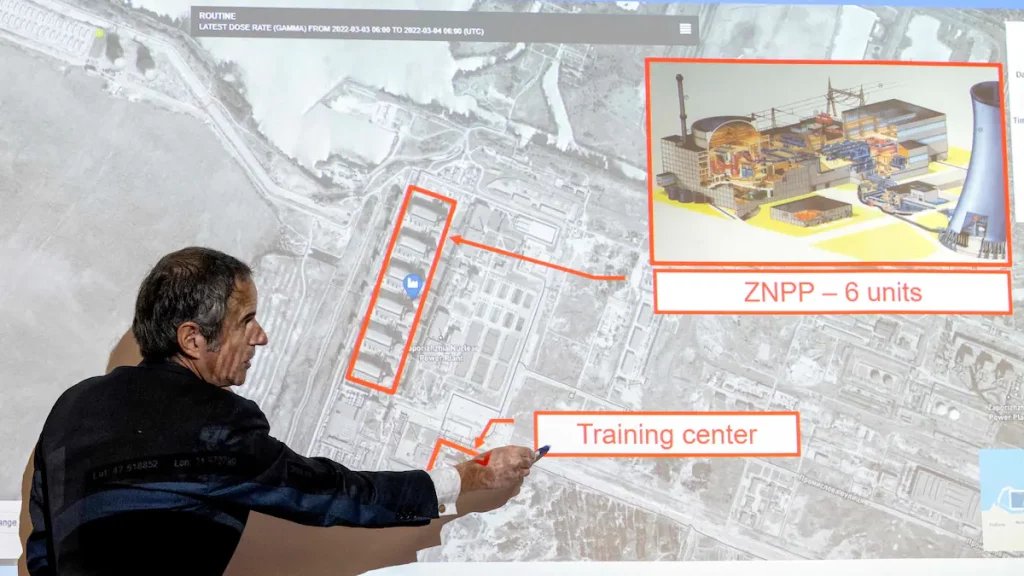Russian tanks fired on Friday at a Ukrainian nuclear power plant in Zaporozhye, the largest in Europe, causing a fire and raising fears of a massive disaster.
• Read also: Russian forces occupy the territory of the Ukrainian nuclear power plant in Zaporozhye
• Read also: direct | The ninth day of clashes in Ukraine
The Ukrainian authorities and the International Atomic Energy Agency said the attack did not affect any key facility of the plant, whose nuclear security was not affected.
Here are some facts about the facilities and levels of radioactivity found in the surrounding area:
The Zaporozhye Nuclear Power Plant is located in southern Ukraine on the Dnieper River, 525 kilometers from Chernobyl.
It is the largest nuclear power plant in Europe, with a total capacity of approximately 6000 megawatts, enough to supply electricity to about four million homes.
In normal times, the site produces a fifth of the country’s electricity and nearly half of its nuclear energy.
The construction of the first reactor began in 1979, when Ukraine was part of the Soviet Union. The plant was opened in 1985 and now houses six Soviet-style VVER-1000 reactors, the last of which was commissioned in 1995.
These reactors have a lifespan of 40 to 60 years, or more as technologies advance.
Listen to Philippe Vincent Foissy’s interview with Guy Marlowe, assistant professor at the Institute of Nuclear Engineering at Montreal Polytechnic, on QUB Radio:
The Ukrainian authorities warned, Friday, that a Russian bombing caused a fire in a building designated for training and a laboratory.
After several hours of uncertainty, the scene was secured and the reactors were “safely shut down,” according to US officials. The fire, which caused no casualties, was put out by Ukrainian firefighters at 6:20 a.m. (4:20 a.m. GMT).
The design of these pressurized water reactors, considered among the safest, comes from those equipped with nuclear submarines and differs from those used at Chernobyl, which are mild to graphite and initially designed to produce plutonium rather than electricity.
Power plants in Balakovo, on the Volga in southern Russia, and Kozlodoy, on the Danube in Bulgaria, have a similar technology.
Zaporozhye VVER-1000s are powered by fuel enriched in the fissile isotope uranium-235.
They operate using steam heated by the core, but unlike other reactors, nuclear contaminated steam is not used to power the turbine, but to heat another circuit of unpolluted steam which then powers the turbine.
This technology makes it possible to maintain a relatively low level of radioactivity for plant employees.
Background radiation around the site was 0.1 microsieverts per hour on Friday morning, according to the station’s operator, which is below the global average and well below the global average from an airplane flight or X-rays.
During the Chernobyl disaster, the level of radioactivity was millions of times higher, at a rate of 300 sieverts per hour.
Après l’opération militaire russe contre l’Ukraine en 2014, Kyïv a développé des protocoles de sûreté pour la protection physique des installations nucléaires dans le pays, avec des inspections régulières, une évaluation des vulnérabilé la misatétrés de en auto le mésérabilés de le data.
The air defense over Zaporozhye was also reinforced.

“Total coffee aficionado. Travel buff. Music ninja. Bacon nerd. Beeraholic.”






More Stories
Fluoroscopy | “Self-coup”?
This is why you find it difficult to wake up in the morning.
She meets her boss at the airport after taking sick leave.